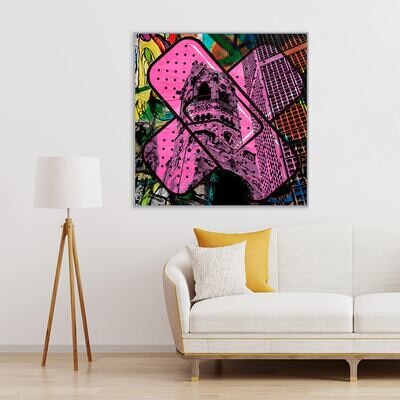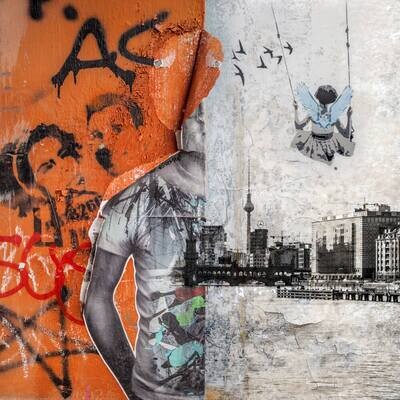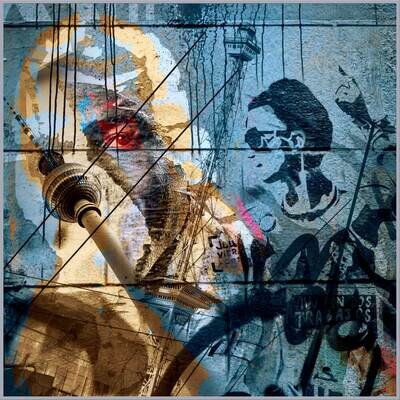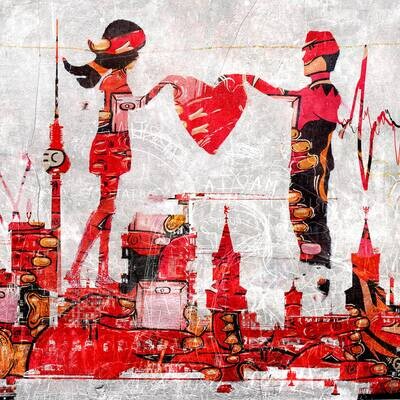echt
berlin
Urban art for home, office, home office or as a gift.
Order selected works from the echt berlin creative approach "Urban Fusing" in limited editions via this shop.
about Alex Huefner
With echt-berlin, Alex Hüfner has set himself the goal of becoming a permanent address for the restaging of urban, contemporary art. In doing so, he closes the gap that exists between established art and subculture.
Urban art should be positioned outside of the illegal milieu and youth centers, represent internationally renowned artists and open a new door for friends and collectors of urban art.
Alex Hüfner sees urban art as a collective term for urban-inspired art that has its roots in (post-)graffiti, stencil art or street art in general, but now has a much richer vocabulary and can be very diverse in scope. The boundaries between “established” and “subcultural” art have long been fluid, and a mutual fertilization can be felt.
At echt-berlin, works of art by well-known and unknown street art artists are re-staged: works by many current talents of the street art scene worldwide are part of Alex Hüfner's image composition.
All works have one thing in common:
They have their origin and inspiration from the streets of Berlin and cities around the world and are known for their murals, taggings and stencils in urban space.
echt-berlin offers exceptional works of art from an exciting subculture and major art movement of the 21st century.
Original and unique works of art for the home or office that stand out from the mainstream.
Affordable Office Art and Kust for the living room, which transform every wall into urban street art scenery.
The works of art can be individually adapted and customized in size and material to all needs.
about echt berlin
echt berlin is the photo artist Alex Hüfner, who has specialized in the field of urban fusing.
The focus is on works by international graffiti artists, which are combined with the photographic art of Alex Hüfner.
Alex Hüfner, who maintains a friendly relationship with many street artists, incorporates the compositions of these artists into his works, combines them with well-known Berlin cityscapes in a creative process and thus gives them a new relevance and uniqueness.
Ephemeral graffiti art is preserved in his works and merges with the Berlin city motifs into a new and unique art form.
As a true Berliner, Alex Hüfner has been documenting the changes in his hometown for years and combining them with the graffiti of international spray artists that he discovered on his travels around the world.
Thus, Echt-Berlin not only offers urban art, but much more a fusion of architecture and cityscape, structures and material combined with the use of graffiti, towards a real urban fusing.
Lexicon street art
Street art or street art is a collective term for art in urban areas. Therefore, many speak of urban art. This not only includes styles, the techniques are also different. With this lexicon I give an insight into the styles, production and approach of the artists who inspire me
cutout
The cut out is a recut motif. The carrier medium is almost always paper and, analogous to the poster, is attached to the wall with an adhesive. The size of a cut-out varies from very small to three or four meter high exhibits.
Artist: The Postman, JR, Judith Supine, Ludo, Swoon, Zilda
stencil
A stencil or pochoir is a template that has to be made beforehand and through which the paint is then sprayed. According to the original use, politicians, political symbols, ideologically portrayed persons or socio-critical motifs are often sprayed.
Artist: Czarnobyl, Nick Walker, Mobstr, Christian Guémy, Blek le Rat, Dot Dot Dot, FAILE, Banksy, Sei Leise
stickers
The sticker can be found in many different sizes and shapes. The distinguishing feature from the other genres of street art is that the adhesive is already present on the carrier material and does not have to be applied on site, as is the case with a cut out. In general, stickers are also much smaller than cut outs.
Artist: OBEY GIANT, FAILE, ZOLTRON, STELLECONFUSE, CLET ABRAHAM, D*FACE, WOLF
roll on
The roll-on is the direct application of paint using a paint roller. This technique originates from the graffiti scene and is used to paint previously inaccessible places. With the help of a telescopic rod, the wall can be reached at a height of two and a half to five meters.
Wall
The mural is a mural. It differs from other works in its enormous dimensions, which cover relevant parts of the wall. It is also known as facade painting. In this form, however, these are commercial orders. In contrast to all other street art works, these are legal works, since permission is required due to the technical and time effort involved.
Artist: BLU, GUIDO VAN HELTEN, FINTAN MAGEE, PABLO KALAKA, ChemiS, RONE, Okuda San Miguel
tile
In this genre, the motif is applied to the tile. This is mostly done by using a stencil or by screen printing. The tile is attached to the wall with an appropriate adhesive.
reverse graffiti
In reverse graffiti, dirty surfaces, especially concrete walls or asphalt floors populated with lichen, e.g. B. with water, soap and brush and high-pressure cleaner selectively cleaned so that the cleaned area shows the graffito.
style writing
Style writing/graffiti writing, or writing for short, is now the most widespread form of graffiti. Due to this circumstance, there is usually no differentiation from other forms of non-writing-related graffiti in the general population. In writing, the writing (letters and numbers) forms the basic element of the image composition.
scratching
The scratching of drawings or writing into surfaces is probably the oldest form of graffiti. Modern scratching, in which tags are scratched with (grinding) stones, broken glass, sandpaper or knives in plastic surfaces or the window panes of public transport such as trains, trams and buses, came in the mid-1990s as a reaction from the writer scene to increasingly contemporary cleaning of painted and sprayed graffiti. In many public transport systems, especially in Berlin, the windows were sometimes scratched to the point of being opaque.






